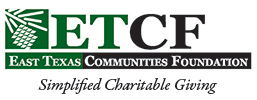It is fall in East Texas and the weekdays, weeknights and weekends are filled with nonprofit luncheons, dinners and receptions. These events are meant to rally existing supporters, introduce new supporters to the work of the nonprofits, and raise critical annual financial support to carry out each organization’s mission. From my vantage point at East Texas Communities Foundation, our mail is full of invitations to these various events, and our weekly grants include a wide assortment of event sponsorships and annual grants benefitting local nonprofits.
In the swirl of social events and fundraising activity, it is easy to start believing that money can meet every need and solve every problem. Years ago, I worked for the Baylor Alumni Association and I’m smiling just recalling one of my experiences in that position. Dr. Paul Powell, longtime pastor of Green Acres Baptist Church, was serving as Dean of Baylor’s Truett Seminary at the time, and I had the privilege of driving him to several alumni events around the State of Texas. He would speak over lunch about the programs at the seminary and he would always close with a direct appeal to those in attendance. He would say, “I need you to do two things for the seminary. First, I need you to pray for the seminary, and second, I need you to give money. But if you can only do one of the two, I need you to give money, because I can always find someone else to pray.” There is no doubt that money is essential to operating a nonprofit, but there is one other resource that is equally essential.
A nonprofit organization cannot operate without funds to support its work, but the most essential resource utilized by nonprofits to fulfill their mission is people. I had the opportunity to attend the PATH Celebration Dinner recently and learn more about their work and their accomplishments during the past year. PATH served 8,117 families last year, which means they met one-on-one with nearly 40 people per day. These individual meetings are where the real work of PATH is done. In the social services world, the term for this work is case management. Case managers are compassionate people who listen to the stories of people seeking help, and attempt to connect them to community resources to meet their needs. More specifically, case managers sit down with clients, learn who they are, assess their current situation, consider each person’s available resources and skills, create a plan to meet their immediate and long-term needs, and connect them with community resources such as housing assistance, utility assistance, food assistance, and medical or dental assistance. This type of work requires skilled and compassionate people. You could, perhaps, program a computer to ask certain questions and use algorithms to suggest solutions, but a computer can never provide human compassion and encouragement.
PATH is not alone in providing one-on-one compassionate care for our neighbors. PAVE East Texas (the former Literacy Council of Tyler), provides compassionate educators and mentors for their students, as does Christian Women’s Job Corps for the women in their skills training programs. Case managers at The Salvation Army receive clients daily who need food, shelter, or assistance with addictions; and the compassionate doctors, nurses and staff at Bethesda Clinic provide healing and hope for the patients they serve. Each of these organizations relies heavily on compassionate staff to deliver their services. In the nonprofit world, high personnel costs are sometimes viewed negatively, but I would argue that compassionate staff are the primary service provided by many nonprofits. If you disagree, try running a school without teachers, a clinic without doctors, or a social services organization without skilled case managers. All organizations cannot be compared equally. It is important for donors to understand how nonprofits spend resources to accomplish their objectives. The East Texas Food Bank spends 8% of their operating budget on personnel because they spend 85% of their budget to purchase and distribute food. PATH spends a higher percentage of their budget, 25%, on people because they conduct extensive case management as a core part of their work, yet they still spend 75% of their budget on direct assistance to their clients. PAVE spends 52% of their budget on people because they are delivering adult education through teachers and mentors. As you sort through your event invitations and annual appeals this fall, understand that your contributions often support the vital work of people helping people. Perhaps a gift to support compassionate case managers, healthcare professionals or educators is your next best opportunity to give well.


Recent Comments